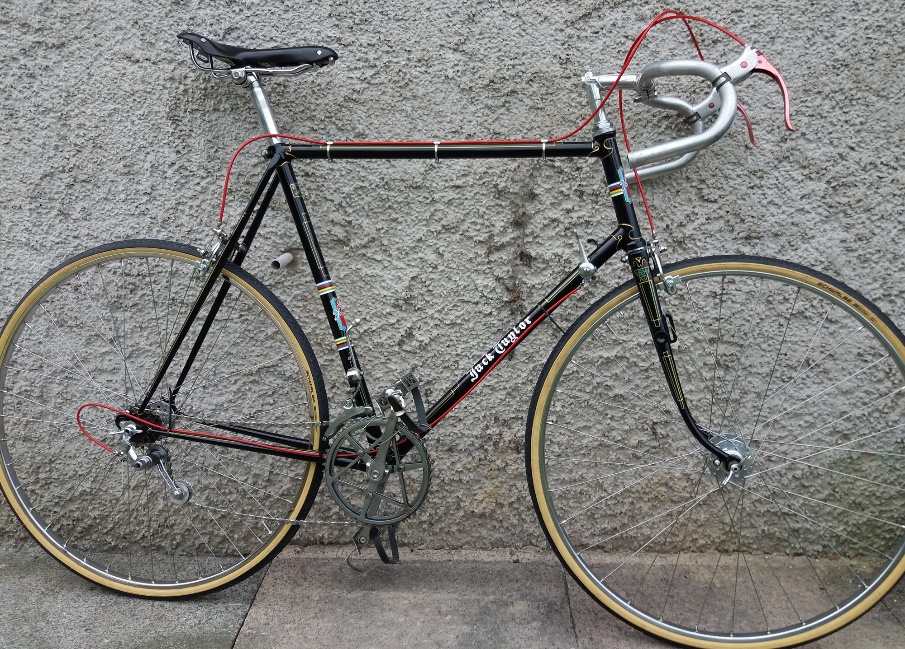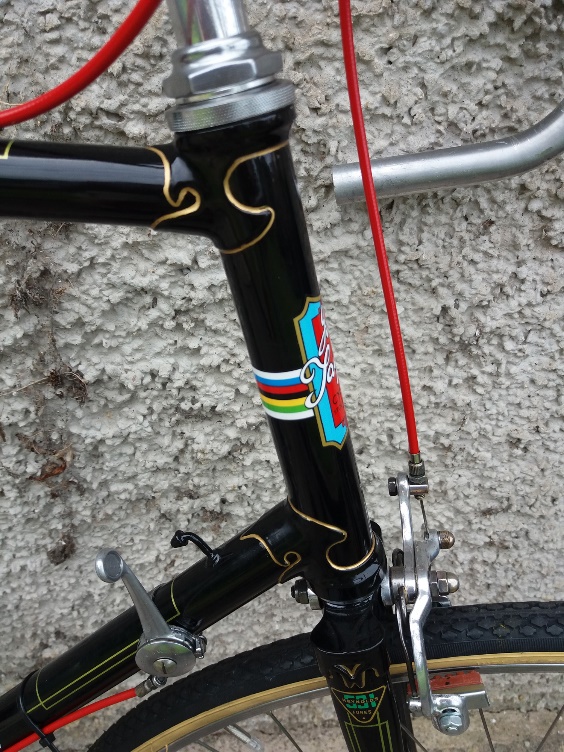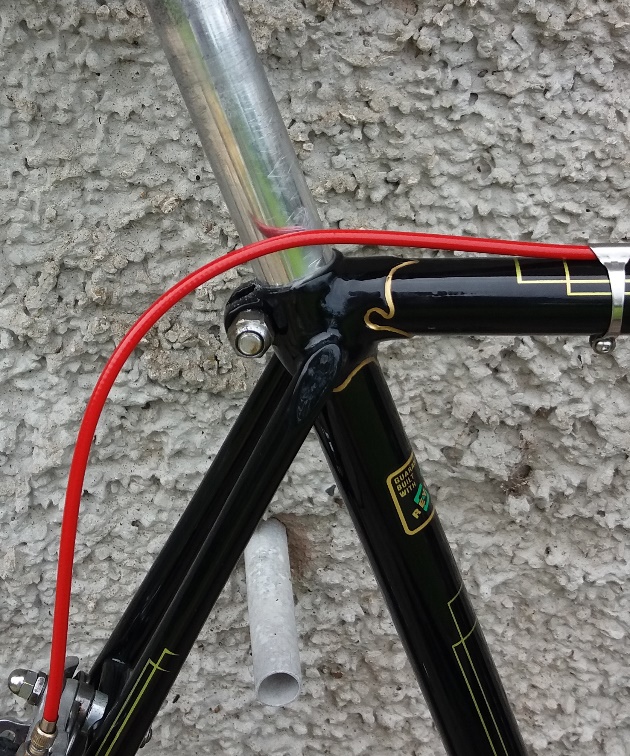Vol. 2, Issue 76 - July / August 2018
Posted: Monday 16th July 2018
In Lightweight News 75 I went into some detail concerning professional style backdrops for photographing cycles. I detailed white photographer’s paper and an even better black backdrop, all of course used as a backcloth with the cycle displayed in front resulting in a plain background as seen below.
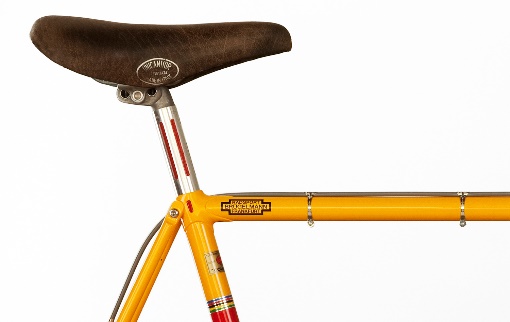
We (Patricia and I) also have an interest in art and as a result sometimes end up in art galleries and studios. I was intrigued to see a photographer with the same large area of black material but not behind the subject which was a picture hanging on their wall. In this instance the image was on a white wall and the black backing cloth was set up some 2 to 3 meters in front of, and away from the subject. This puzzled me until I was later talking to the photographer about the problems I have of taking images of glazed works where I always ended up with an image of myself and the wall/ furniture behind me reflected in the glass – the darker the subject being photographed the worse it is as the picture becomes effectively a very good mirror. I was then told what happens in galleries/studios.
In this case the blackout is to provide a perfectly neutral wall behind which the photographer lurks, taking the image through a small hole the size of the lens and hey presto an image with no reflections.
We have recently returned from a holiday cycling on the Bodensee and the Allgau at the southern tip of Germany where it joins Austria and Austria joins Switzerland. There are not that many lightweights seen in this area as the cycling is mainly recreational and touring, often by families. Every time I visit Germany I am struck by the large number of E-bikes, often built around the Bosch bottom bracket power unit which fits particularly well into mountain bikes without looking too bulky. When passing through a railway station with time to spare, we looked into a newsagent/bookshop and saw in the magazine section that there were no less than six glossy magazines about E-bikes. I wonder if any of them had tips on de-regulating the controls on speed.
I follow the development of E-lightweights as an age-related insurance policy but feel that the weight penalty for unassisted riding is a bit too much at the moment. I spend many thousands of miles every year riding with people twenty-plus years younger than me (sometimes more). This is a big part of my life and I don’t wish to give it up but just feel the need for a boost now and then, often on the last 200 meters of a hill or if I suddenly get exposed to a headwind in the group when travelling at speed. I have read about what is known as motorised-doping at some races and this is done with a motor hidden in the seat tube, presumably with the battery seated above it. This must be a lot lighter than some units on sale but if bought legally would be required by law to cut out just when I need it – about 15mp;, it could help up hills I suppose.
The other feature apart from weight is size and bulk but this is slowly getting better with some units tailored into an oversized down tube which doesn’t look too bad as several modern carbon bikes already have oversized tubes for either strength or aerodynamics. If you suddenly see me flying up hills leaving the group behind you will know that I have finally dotted all the “Is” and crossed the “Ts “and managed to overcome the speed governing mechanism/electronics.
A Hertfordshire Boyhood by Seb Macmillan
Among my earliest memories is of a group of young Italian cyclists who had stopped for a break and were sitting all over the outside stone steps of the bedsit that my mother and I shared when we lived in Italy when I was three and four. I wanted to go out to play and asked her to come and tell them to let me through, to which she replied that I should ask them myself. I have a strong recollection of the brightly coloured tops and bikes glinting in the Italian sunshine. Soon after back in England, I had a Raleigh tricycle – blue and white with the hinged-lidded boot between the back wheels, and a clever telescopic stick stored in the hollow rear axle that the parent could use to assist or restrain.
At age 7, I was bought a bright red Halfords roadster with 24-inch wheels and rod brakes. I think the shop, Halfords in the Market Place, St Albans, must have seen my mother coming because even by then rod brakes were well out of fashion and all my friends’ bikes had cable brakes. Still, I have vivid recollections of the gleaming chrome and shiny frame and the thrill of learning to ride a two-wheeler. It gradually acquired battery lamps and a mirror. At some point the crank started hitting the misaligned chainguard causing a complaint from a neighbour early one Sunday morning. My first ‘distance’ ride was made on it with a boy who lived a few doors away from me in Redbourn, Hertfordshire; we cycled around Luton and Harpenden, which my father estimated at 30 miles. He himself had a Hercules sit up and beg bike, second-hand, which he rode until he died in 1983.
I went straight from the Halfords to a Raleigh Blue Streak, purchased by my mother through Exchange & Mart for £10 and delivered by a British Road Services lorry (the one with the three-wheeled front cab). I was 11, and the bike was far too big for me. It didn’t really matter – it had 10 Benelux gears, with five cogs at the back and a ‘double clanger’. A cycling friend of the family who was used to touring was highly critical of the ratios – the chainwheels were 49/46 and as he said, this didn’t give very wide choice for hills. The block was 14-24.
I was still young and very new to mechanical things, my father wasn’t particularly good with bikes and, I must admit, I never managed to get the rear mechanism to cover all five cogs. I could never get into the top gear, vitally important when you are that age and I was a bit of a perfectionist. No doubt it was adjustable, but at the time I thought it wasn’t working and I lost my enthusiasm for the Blue Streak – eventually ending up repainting the frame by hand extremely badly and selling it very cheaply to a neighbour. My big trip on it was to cycle to Chelmsford one Saturday in 1964. It was a round trip of probably 90 miles or so from home. A friend of mine and I agreed to do it one Saturday. We left around 6.15 in the morning and followed the A414 all the way there. I was 12 and my companion, Brian, 11.
Luckily at Chelmsford we agreed not to continue on to Maldon, which had been a potential part of the trip – I say luckily because when we turned to come back, we realised there was quite a strong headwind which we hadn’t noticed on the way out! I had an old Bartholomews Road Atlas at 5 miles to the inch and we turned off the main road hoping to find some shelter from the wind in the lanes. Eventually I got home about 8pm but my companion had to be rescued by his father driving out to collect him.
We had had fish and chips for lunch in Chelmsford and I had dutifully brought home the chip paper wrappings in my saddlebag. They were left in the saddlebag overnight and must have attracted mice, because in the morning, my mother discovered that my grammar school woollen hose (I was still in short trousers) bought at some cost from the school outfitter at my new grammar school had been badly chewed up and were a write off.
On the return from Chelmsford I caught up with another cyclist and we got chatting. He had a hub gear combined with a two or three speed derailleur, which I had never seen and was intrigued by. When he found out that I came from near Luton, he suggested I look up Wally Angel at Diamond End, who had a big collection of veteran bikes. Three years later, I cycled over to Diamond End and located Wally Angel. He had a Nissen Hut in his garden filled with fascinating old bikes, not least a tandem made for four or five riders and used for pacing on the track. No doubt Wally has long been curating that great cycle museum in the sky, but I see from Google Streetview that the Nissen Hut is still there. I wonder what happened to the collection of bikes.
In 1963, the year before the Chelmsford adventure, I started at St Albans Boys’ Grammar School in Fleetville, St Albans, taking the 343 London Country bus service from my home five miles away in Redbourn. I arrived and departed daily at the Cemetery Gates bus stop, right next to Stan Miles bicycle shop on the Hatfield Road (this was the early 60s before he moved to Victoria Street.) The shop was run by Stan and his wife. He was a well-known local cyclist with Verulam CC and had won the BBAR competition in 1935, as I discovered in a book at school a few years later. I was so pleased to find a photo of him on the classiclightweights website, presumably taken in about 1935.
Stan Miles’ shop exerted a powerful influence, and I must have ogled his window display almost daily for the best part of seven years. It absorbed a large fraction of my pocket money over much of that time. The first big purchase from him was a Freddie Grubb Coureur racing bike, bought on hire purchase when I was 14. My father worked in Dunstable and had to leave work early to get to the shop to sign the agreement. I can’t remember the cost of the bike, but the weekly payment was 8s 9d which I took into the shop every week.
We were not well off and it was incredibly indulgent of my parents to buy it, especially as I’d had the Blue Streak only two years before. In silver and black, it had 5-speed Campagnolo Gran Sport gears, Weinmann 999 centre-pulls and a Brooks saddle. I did a lot of riding on it around the village, and on Saturdays I would ride off for the whole day. I had day trips to Oxford and Cambridge, both of which are something under 100 miles round trip, and Bletchley a modest 40. Sometimes I rode alone but occasionally I was able to persuade one or two school friends to come. At least one of them ended up convincing their parents to buy them a decent bike, having struggled to keep up on a roadster.
Ironically it was the travelling rather than the destination that was important – as I remember, even visiting Oxford or Cambridge simply meant passing the town sign to know you’d arrived, and then finding the nearest fish and chip shop to buy lunch and turning for home! Once a friend and I cycled to Colchester and stayed with his grandparents, where we did see a bit more of the place. It seems extraordinary today but, with the ambition to get to a particular town, I mostly used main roads; this made it easy to navigate since my only map was the Barts road atlas, although I did eventually acquire some Bart’s half-inch maps; while not absolutely accurate, they covered large areas and were fine with teenage eyesight.
Much as I enjoyed riding, tinkering with bikes became a hobby of equal pleasure. I acquired all sorts of spares and when an old touring bike was dumped in a field near a garage having been bent in a car accident, my father helped me bring it home to be stripped down. He said it had the smell of death, and certainly it was badly crumpled. Other boys in the village had already taken some of the parts, but I got the chainset, the Campag Gran Sport front mech, and a Campag handle bar control which was quite a prize.
The other had been taken off by a boy I knew who had then thrown it away, not really knowing what it was. I was astounded as the Holdsworth catalogue, Bike Riders’ Aids, listed them at 25 shillings [£1.25] – a fortune when you are a boy on pocket money of three or four shillings [15-20p] a week. It might even be from this that I became enamoured of Campagnolo, leading to a trip to the factory as I will explain shortly.
So I was a regular visitor to Stan Miles shop and I built up and sold several complete bikes, mostly 5-speed bikes with drop handlebars that were ubiquitous in the sixties. I was completely addicted to Bike Riders’ Aids, which became very well thumbed.
My Freddie Grubb – which of course was not a real Freddie Grubb at all but a fairly cheaply built bike produced by the Holdsworth company and badged with the historic name – came to an unfortunate end. Heading off early one Saturday morning on a planned ride up Watling Street to Bletchley, head down on the drops, I ran straight into the back of a neighbours’ builders van. The top tube and down tube both buckled just behind the head tube. Remarkably, the front wheel was okay and so were the forks, and in fact it was perfectly rideable.
So to the Campag factory. In the mid-60s my father was working at Vauxhall Motors in their Dunstable plant where they built Bedford vans. He was hit by a fork lift truck on the shop floor and eventually, after being checked over by doctors, given some financial compensation. It was used for a family holiday in Italy, where my father had relatives. As well as seeing them, I got my mother to write to the Campagnolo company and we visited the factory in Vicenza. It was a sea of lathes and lathe operators but we were very well treated and at the end they presented me with a Record rear mech! But what I really hankered after was a chainset and my parents bought one from the factory there and then. I knew the rings I wanted – 50/44. Goodness knows how much it must have cost. It was carefully brought back and declared at Customs, but I don’t think we paid any import duty.
There was one problem with the chainset: lack of tools. Looking back, my toolkit was incredibly basic. I had a couple of pressed steel spanners that must have come with one of the new bikes, an adjustable spanner, a smallish screwdriver, and a pair of pliers. At some point, my father bought a set of spanners for me. How did most cyclists deal with cotter pins? When I bought them, the flats were never ground down far enough and I always had to file them. I bought a flat bastard file from a hardware shop and luckily found that the latch on our side door was a perfect holder for the thread as I filed away. I had no bench or vice.
By this time I had started to grow rather tall. I was about 5’ 7” when I had the Freddie Grubb, but I grew nine inches in three years between the ages of 14 and 17, and began to look for a larger frame. Cycling down to Wandsworth to visit my uncle, I passed Fred Dean’s shop and there in the window was a second-hand 25 inch frame at £9, which I bought. Although it was 531 and had Campag ends, it was really a touring frame. It had shallow angles and Mafac Driver cantilever brakes that luckily had come with the frame. I didn’t really want to put the Campag chainset on it since I would not be able to get it off myself without somehow getting it to Stan Miles’ shop, and instead bought a Williams C34 steel chainset. I chose 50/36 rings and I took a gamble that the rescued Campag Gran Sport front mech would cope – which it did. I’d invented for myself today’s compact chainset! The block at the back was a relatively standard 14/24 – wider ratios were available but seemed very expensive by comparison and I was always on the pocket money budget.
The Fred Dean served me really well, although I did have another incident on it, similar to the first – head down on the drops I ran into the back of a delivery van parked on the main A5 at Bow Bridge between Redbourn and St Albans. Same damage as the Freddie Grubb. I took it all the way back to Wandsworth on a series of buses to have a new top tube and down tube fitted. The wheels were steel rims on plain hubs from St Albans market rather than Stan Miles. But I went on two fortnight-long youth hostelling holidays on it, the first in 1967 from St Albans to Plymouth and back via the north coast of Devon, and the second across to Aberystwyth in 1968. Three of us went on the second of these and in fact I built up a bike for the third companion, based around a lugless Claud Butler frame. I planned out a complete ride along the Fosse Way from Lincoln to Exmouth, but never did it sadly.
Sometimes building up second hand bikes could be quite profitable and on one occasion, I made £10. It was enough to buy a pair of the best wheels you could possibly own – Fiamme sprint rims on Campag Record Large Flange Quick Release hubs. Stan Miles built them for me with double-butted chrome spokes. It was a kind of madness really because I couldn’t afford tubs, which anyway were quite unsuitable for everyday riding; so the wheels sat in my bedroom for about 2 years before being used!
So finally to my classic lightweight. Brian Oliver, who will be a familiar name to many from that era, used to advertise second-hand equipment in Cycling Weekly and I rode a few times to his home in Kilburn – easy navigation, it was a straight run from Redbourn down Watling Street, the old A5. He was riding professionally in France during the summer and living with his parents in the winter and dealing in bike parts. He either had or found for me a 24 inch Alan Shorter frame. It was bright orange. It had Campag vertical dropouts, seat stays that came up behind the seat tube to a neat allan key seat bolt and a sloping fork crown. As luck would have it, it had cable stops and guides for handle bar controls. Finally this was really it! I must have been 16 or 17. Stan Miles fitted the Campag chainset and I put on the Record mech donated by Campagnolo. I bought a Record front mech to match. I was able to use the found handle bar control, though I had to buy a second one, at 25 shillings. It had Mafac Racer brakes with Weinmann levers and a Unicanitor nylon saddle. And of course it took the Campag Record LFQR wheels.
I couldn’t afford new tubs but, on an occasional visit to the Verulam CC HQ in the old Sea Scouts Hut at Westminster Lodge, someone kindly gave me a handful of old punctured ones. I carefully unstitched them and repaired the inner tubes and stitched them back up again. So much time and energy you have when you are young! Cycling Weekly, which my father bought for me for a whole year, was always going on about shellac, but I used Dunlop cement which was like thick rubber solution and came in a can with a brush in the lid. It was messy to say the least.
For the handle bar controls a friend, Mark, brought round his father’s Black and Decker electric drill and we drilled cable holes in the handlebars – about an inch or two from the end and carefully angled so the cable could run up inside, and then about four inches from the stem also angled so it could come out again and down to the guides and stops. We had no vice, no bench – it was all done on the lino on my bedroom floor. I held the bars and Mark drilled!
What did I do with the Shorter? With the Fred Dean as my everyday bike, and the business of the tubs, it was hardly ridden. On one of the few occasions I rode it to school, I got a puncture and had to borrow a spare tub from Stan Miles, which he was happy to lend. But the tubs and their cement dissuaded me from using it much.
Then, aged 18, I focused on A-levels and got a place at Liverpool University. I worked for a travel agent all through the summer holiday immediately before going up, so no cycling that year. I can’t really explain it, but I completely lost interest in cycling. The Fred Dean was sold, as was the Shorter. There isn’t even a photo of the Shorter. But whoever bought it got a bargain in that the transmission and the wheels were almost brand new, having done a couple of hundred miles at most. From memory, it went for £40. I wish I had it today! I didn’t have another bike until more than 20 years later, in my early forties. But that’s another story. Though I can say that when I took it up again in the early 1990s, Stan Miles was still to be seen riding with friends on Sunday mornings. He died in 2004.
I’ve been scrolling through your website, and the following thoughts occurred to me, based on my own experience.
Further to Peter Bruggeman’s tips on adjusting the Benelux and similar what Frank Berto calls “plunger-type” mechanisms, I find that the difficulty in engaging top gear i.e. the smallest cog is usually down to lack of travel remaining on the telescopic shaft. This is because too much adjustment has been used to set the mechanism onto the largest cog.
Users of Atom/Maillard hubs will be aware that spoke breakage is more common on these hubs, and by comparing them with Campagnolo hubs of similar vintage, the principal difference is that the spacing washers give much more clearance to the gear side, thus leading to over-dishing and subsequent problems with spoke breakage.
I have concluded that this extra spacing dates back to the era of those Benelux gears, the additional clearance giving the necessary distance for the mechanism to work smoothly. They just don’t work so well with the closer clearances required by parallelogram gears, which, starting at the other end, need to be as close as possible to the freewheel in order to engage bottom gear (the largest cog) before running out of travel.
To avoid building a weaker wheel, more space needs to be put between changer and freewheel, either by a spacing washer between the mechanism and its hanger, or by carefully bending the arm outwards at the top and then back inwards at the bottom, so that the hanger and cage are still parallel. The problem with the latter is that it may weaken an elderly piece of metal beyond endurance. The earlier Benelux arms had this bend; the later Mk 7 had a straighter arm, and compensated for the extra space by using a hanger that incorporated a bend, in the style to be seen on several rear drop-outs of the period (Cyclo, Agrati, Simplex) that incorporate a hanger. Perhaps a combination of all three, i.e. a small extra spacer on the axle, a washer on the pivot bolt and a tweak of the arm will be the best solution.
If using the Mk 7, check that the hanger is the correct one for that model; they are often offered with a straight hanger.
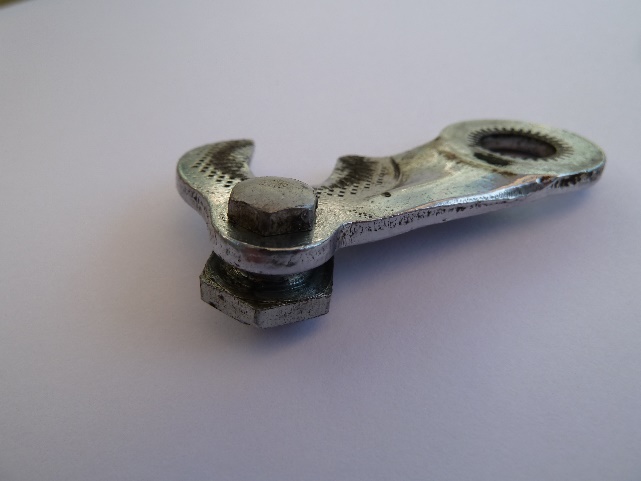
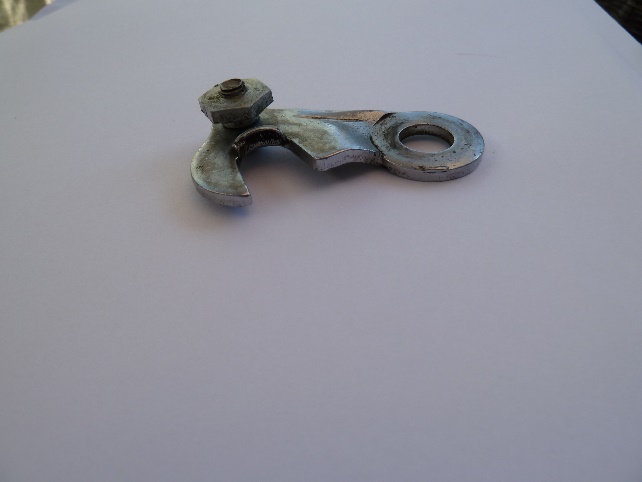
Mike Baker – I was interested to see the comments from John Bassell about Joe Whisker, as I used his Mail Order lists for many years, first at Willesden Lane, Kilburn, then when he moved to Goffs Oak. Many items were discounted, for example, a January, 1963 “ Cycling” advert has him selling “Brooks B17 narrow special export quality saddles at 37/6d each”, exceptional value.
Another interesting character was George Reed, of Kingston Road, Wimbledon, who was partially sighted and identified cycle parts by feel. We in the San Fairy Ann CC would cycle up to his shop from Maidstone, a round trip of 70 miles on 72inch fixed gear. In the same “Cycling,” George had “Bankrupt frames of well-known lightweight company at £4-19-6d; Helyett frames, light blue, with double chainset; £7. 15. 00d”. Also from Walter Flory, “Weinmann Vainquer 999 centre pull brakes, with white rubber hoods, 65/00d.” Then there was Ted Gerrard from Finchley, who offered “new parts for old”. You sent your old cycle parts to him and he part-exchanged them for new. I could never work out how he made any money and he eventually went bust. The administrators sent back my parcel of old useless part-exchange cycle parts a year later! This is how we bought our discounted cycle parts in the 1950s/60s, which I suppose was the fore-runner of modern Internet buying.
These pages from the 1952 edition of Aids to Happy Cycling give some idea of repairs and renovations on offer in that era. The services also give some indication as to the choice of paintwork available to the purchaser of a new cycle. I sometimes get asked advice on this subject and have to explain that for custom-built frames just about anything could be ordered. You wouldn’t think a brown frame would look much but properly painted with some contrast in the form of panels or lining the result could be quite pleasing. My friend had a frame painted black with panels and at the same time I went for white with red head tube and panel on the seat tube. Other club members went for any colour taking their fancy from pink to purple and anything between.
It is interesting to see that although this booklet was published in 1952, austerity still ruled (it still does here in the UK) and the government had banned the use of nickel.
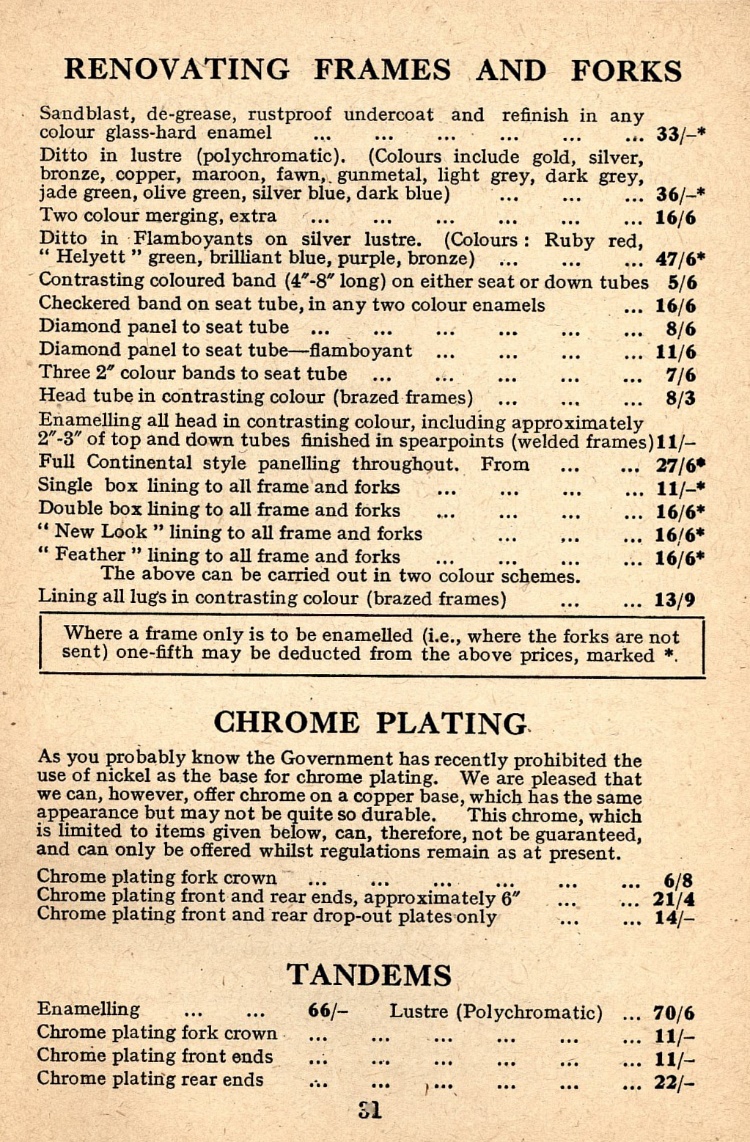
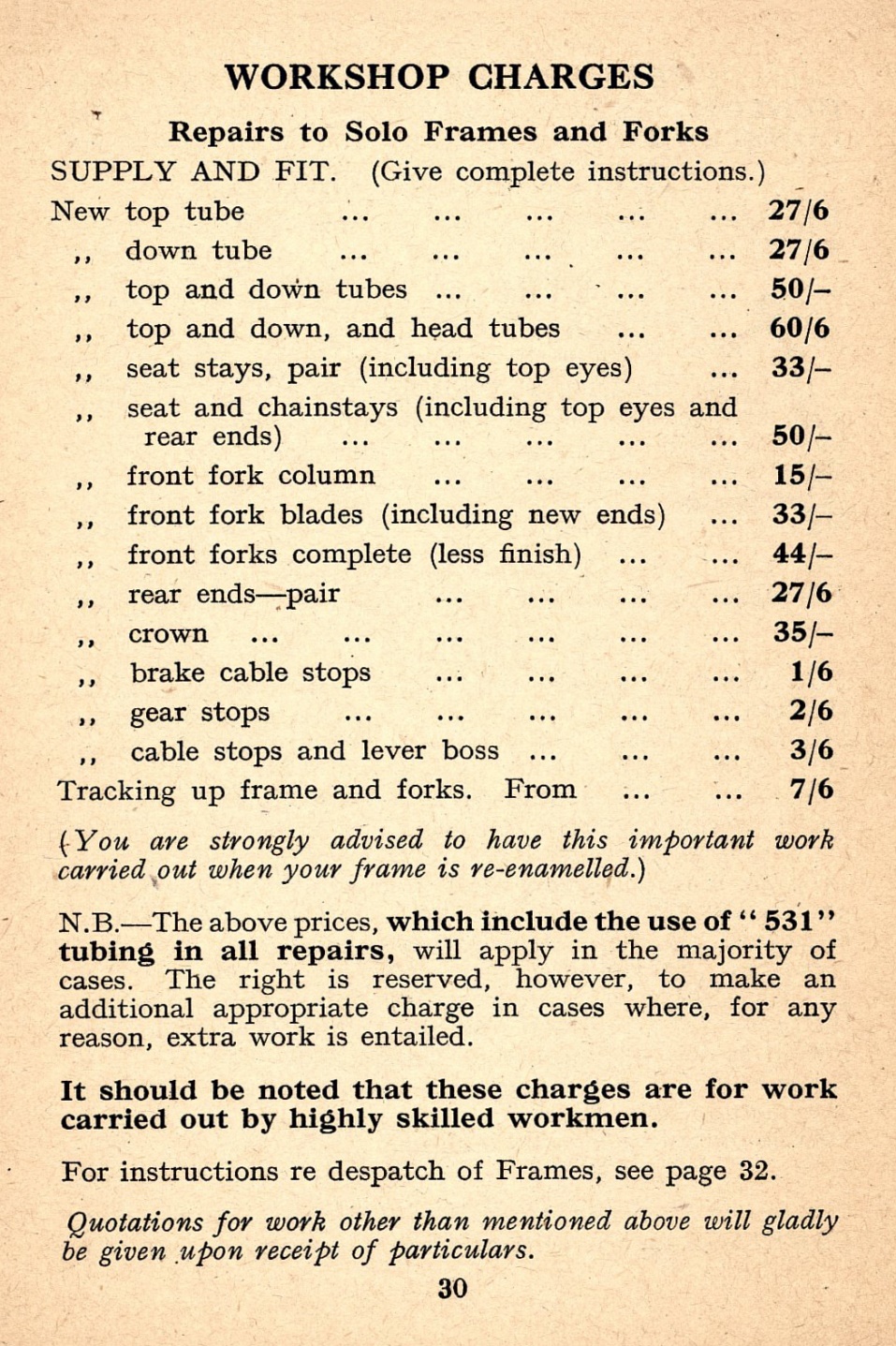
As part of the Wallingford Festival of Cycling we’re having a screening of ‘A Sunday in Hell’, the documentary about the 1976 Paris Roubaix, including a Q&A with the author and journalist William Fotheringham who has recently released a book about the film. It is on Saturday 7 July 2018, 7:30pm.
Given the vintage nature of the film I thought it might appeal to some of the classic lightweight audience.
Further details can be found at : http://www.wallingfordfestivalofcycling.co.uk/programme/sunday-in-hell/
Fergus Muir:
I have purchased from the estate of Albert Gravenor more volumes of loose pages from “Cycling” for the years between 1922 and 1947.
In the edition for October 12th 1938 I found Cycling’s quite detailed account of
GEORGE LAWRIE’S 1000 MILE RRA TRICYCLE RECORD IN 1938
The article tells how George set out from the 33rd milestone on the London – Cambridge road on a Wednesday morning and finished at the same milestone on Sunday afternoon, having covered the 1000 miles in 4 days 6 hour 35 minutes.
His course went north through York to Newcastle and as far east as Ipswich.
Cycling says: “His tricycle was equipped with 27” sprints and tubulars and a derailleur gear that gave him a ratio of 61ins 71 ins and 76 ins.
Apparently, he only suffered two punctures, despite riding through conditions including hours of continuous rain and winds that reached gale force.
“The weather conditions throughout the ride were terrible” says “Cycling” and indeed the car containing his timekeepers crashed into a ditch in one storm.
George only had ten hours sleep during the whole ride – including one period insisted upon by his helpers after he fell asleep riding up a hill “and the tricycle began to run backwards down the hill”
His times for each of his ten “100”s are quoted as
6 hrs 50 mins
7 10
8 20
8 30
10 34
18 18
8 48
13 23
10 52
9 50.
Apart from the two punctures George apparently had no mechanical trouble whatsoever.
He was a meticulous man and very much a “stayer”
George went on to be National Racing Secretary of the TA for 50 years, and a familiar figure at National Reunion Dinners. Some of you will remember him attending the trike race at the Bungay round-the-houses-races not so very long ago.
I purchased the frame from an eBay seller based in Middlesbrough. He stated he was 100% certain it was as stated. It has been refinished to a high standard but the finisher is unknown.
Since then I have sourced the kit from various sources over a two-year period and attempted to keep it as 50’s as possible and in keeping with a club racer of that period whilst making it usable for the Yorkshire Dales. (Hence the Benelux Touring rear mech). I’ve used it in this year’s (2018) Eroica Britannia where it rode like a dream.
That’s basically the only information I have. I’d like to learn more about it, re: the lugs, model, etc.
John Foster – for sale:
1. Bill Philbrook touring frameset, built July 1975. Seat tube Fillet brazed, seat tube = 22″ C2C. Stunning restoration, not built up since.
2. Ken Bird Time Trial frameset, two-digit BBC frame number, lovely lugs, shot in stays, seat tube = 21.5″ C2C. Needs repaint, will be stunning.
3. Raleigh Superb roadster, 1966, seat tube 22″ C2C, Lovely and original, rod brakes, 4 speed S/A + dynohub, original green saddle, bag and pump and rare steering lock key!
Bryan Clarke – Frames for sale
23” Youngs of Lewisham frame, 1956, refurbished, new metal head badge, Jim Collier built, £120
22” Shop built Holdsworth Professional frame, 1972, (TJQ), refurbished, Campag headset, mudguard eyes and lamp boss – one-off frame £150
Also bikes for Sale
1947 Stephens Special, 23” frame, Williams, Chater pedals, Burlites, S/A FM and LF Airlite on Dunlop LAs, oval badge B17, Reynolds girder stem and bars, Bluemels guards. £550
C1950 Ferris Super Champion, 23” frame, Stronglight/Durax, BOA pedals, early Simplex TdeF gear, Bacon slicers on Dunlop special LW chrome rims, B37 saddle, Hiduminiums, Reynolds girder stem with ?Marsh pattern bars, £750
C1946 Evelyn Hamilton,22 ½” frame, Osgear, Lytaloy C/S, Lyotard 45ter pedals, oval badge B17, Hiduminiums, FBs on Fiamme, GB spearpoint and Maes bars. £700
Posted: Monday 16th July 2018
This article appears in the following categories.
Upcoming Events
Whether you are looking for a gentle social meet up, or a 100-mile ride browse the community’s upcoming events and plan your next weekend outing.

